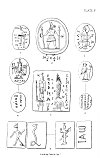
Masonic, Occult and Esoteric Online Library
The Gnostics and Their Remains
By Charles William King
Ancient Egyptian Types Adapted to Gnostic Ideas

PLATE F.
ANCIENT EGYPTIAN TYPES ADAPTED TO GNOSTIC IDEAS.
It is in this class that the influence of Judaism is more strongly marked than in any other family of these monuments. These gems were designed as amulets against the power of demons, either considered specially, or as manifested in the diseases of which they were the final cause to mankind. But before proceeding further, it will tend much to the elucidation of this curious subject briefly to sketch the orthodox Jewish doctrine upon this point. There is no such thing in existence as a spirit naturally evil, inasmuch as God, being all goodness, was absolutely incapable of creating evil. Satan is himself an angel, like the others, and has his own place in the Court of Heaven; but he is deputed to test, by temptation, the strength of Man's virtue, since without a struggle there can be no crown. The Babylonian Rabbi, Philemon, * having demonstrated this grand truth to the satisfaction of his numerous school, was surprised the next day by a visit from this Ange mal entendu, in a bodily shape, who tendered him public thanks † for the pains he had taken to set his character in a true light. But, unfortunately, the Demiurgus had commenced his work by creating so vast a number of spirits, that the Sabbath-even came upon him before he had made bodies enough for half of them. These poor houseless beings are not naturally malignant, but are jealous of their more fortunate brethren, for the same reason that "the man who has no coat to his back hates the man that has." They therefore roam up and down the world, ever striving to force their way into bodies already occupied, where their struggles with the rightful owner give birth to all the maladies that flesh is heir to. It is remarkable that the latter belief is universal among primitive races, however widely separated--the Samoiedes, the Hindoos, the Red Indians. Something similar, too, may be found in Plutarch's curious disquisitions on the nature of demons, contained in his two Treatises upon Oracles.
It is the fashion of our days to believe that the Jews borrowed all their metaphysical theories from the Platonists of Alexandria; but whoever has gone deeply into the subject sees good reason to suspect that both Jews and Greeks had gone, independently of each other, to a much more ancient source for such traditions.
1. The Agathodæmon Serpent, mounted upon a pair of human legs. A unique variety of the class--the same idea being more usually embodied in a human figure with head and neck of a serpent; or in a serpent with the head of Serapis. The long invocation on the field evidently begins with the name of "Abraxas."
2. The jackal-headed Anubis, an Egyptian sceptre in each hand, advancing between the Sun and the Moon, the regular emblems of Eternity. A remarkable specimen of religious syncretism, for the power of the Pharaonic god is doubled by adding, on the reverse, the name of Michael, guardian-angel of the Jewish race, between four stars, which certainly stand for the letters of the Great Tetragrammaton.
3. Mummy, enveloped in the folds of the guardian Agathodæmon. The detached letters around (often so found in these gems) seem to cloak the word "Initia." If so, this may have been a token (symbolum) given to the neophyte upon his initiation into certain mysteries: a custom to which St. John alludes, mentioning the "white stone" with the New Name graven thereon, to be given to him that overcometh.
4. A Power equipped with double arms and wings, bearing sceptres to mark his dignity, and carrying on his head the sacramental Table. The tree-trunk below, with its Five lopped-off branches, had doubtless a deep mystic meaning, probably the degree of the person who carried the talisman. Of the most barbarous execution, but valuable for the name "Baincho" on the reverse: the astral Power, according to the "Pistis-Sophia," resident in the planet Mercury.
5. Anubis, in one hand the sceptre, in the other the lustral vase, standing above the open left hand, which Apuleius informs us was the type of Justice. At his side is the goddess of Truth, her head formed out of a bunch of ostrich-feathers: under her feet the udder-shaped vessel carried in the Isiac procession. One deity is invoked by "Thou art our Father!" the other as "Sun of the Universe!" The letters in the middle seem to make up the owner's name, "Pia . . ."
6. Anubis, advancing with the sceptre and situla: the legend on the reverse is unexplained.
7. A talisman, certainly meant to be of mighty efficacy, for it combines the influences of Anubis, Cnuphis, and Horus with that of the God of the Jews, rudely cut upon the four sides of a cube of steaschist.
Footnotes
439:* Or "Polemo," as the Hebrew may equally well be read.
439:† "Kissed his knees" is the expression in the Talmud.
